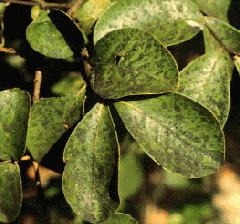Source(s): Randy Drinkard
Sooty mold frequently develops on the foliage of many ornamental plants in late summer. It covers the top surface of leaves, thus, reducing the photosynthetic process of the leaf.
Biology
Sooty mold is often not noticed until a large number of leaves are covered with a black sooty substance. This is not really a disease, but a black fungal coating on leaves. Sooty mold is an indicator that there is an insect problem on the plant. The insects feeding on the plant are excreting a sugary substance called “honeydew”. The fungus doesn’t feed on plant tissue but on these secretions from the insects that are feeding on the plant.
Various fungi, Capnodium spp., Scorias sp., Fumago sp., associated with specific insects (aphids, scale, whiteflies and other sucking insects) and plants (fig, crape myrtle, azaleas, tuliptree, oleander, osmanthus and other ornamental plants) produce the sooty mold coating. The feeding of a large number of these insects and the coating of the sooty mold may lead to reduced vigor in the plant. These sucking pests take in large amounts of sap. Much of the water and sugars in the sap pass though the insect and onto the leaf. Rain usually will wash this residue off. If there is insufficient rain then the “honeydew” sticks to the leaf.
Control
To control sooty mold first control the aphids, scales or other pests that are creating the honeydew. Aphids can often be washed off by a strong spray of water from the hose. This action may also wash off some of the “honeydew” and sooty mold. Remaining sooty mold will eventually dry up and flake off the leaves. To control heavy infestations of aphids, scale, mealybugs, etc. on ornamental plants, use acephate(Orthene), malathion, imidacloprid or other recommended insecticides.
Resource(s):
Insect Pests of Ornamental Plants
Center Publication Number: 56
- Saddleback Caterpillars: Watch Out for that Sting - September 26, 2018
- Hanging Baskets - September 24, 2013
- Houseplant Help - September 24, 2013
